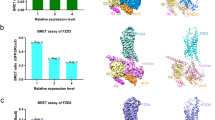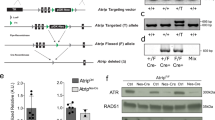Abstract
The lens epithelium-derived growth factor (LEDGF/p75) tethers the mixed-lineage leukemia (MLL1) protein complex to chromatin. Likewise, LEDGF/p75 tethers the HIV-1 pre-integration complex to chromatin. We previously demonstrated that expression of the C-terminal fragment fused to enhanced green fluorescent protein (eGFP) (eGFP-LEDGF325–530) impaired HIV-1 replication. Here, we explored this strategy to selectively interfere with the leukemogenic activity of MLL-fusion proteins. We found that expression of LEDGF325–530 impaired the clonogenic growth of MLL-fusion gene transformed human and mouse hematopoietic cells, without affecting the growth of control cells immortalized by the FLT3-ITD mutant or normal lineage-marker-depleted murine bone marrow cells. Expression of LEDGF325–530 was associated with downregulation of the MLL target Hoxa9 and impaired cell cycle progression. Structure-function analysis revealed two small eGFP-fused LEDGF/p75 peptides, LEDGF424–435 and LEDGF375–386 phenocopying these effects. Both LEDGF325–530 and the smaller active peptides were able to disrupt the LEDGF/p75–MLL interaction. Expression of LEDGF325–530 or LEDGF375–386 fragments increased the latency period to disease development in vivo in a mouse bone marrow transplant model of MLL–AF9-induced AML. We conclude that small peptides disrupting the LEDGF/p75–MLL interface have selective anti-leukemic activity providing a direct rationale for the design of small molecule inhibitors targeting this interaction.
This is a preview of subscription content, access via your institution
Access options
Subscribe to this journal
Receive 12 print issues and online access
$259.00 per year
only $21.58 per issue
Buy this article
- Purchase on Springer Link
- Instant access to full article PDF
Prices may be subject to local taxes which are calculated during checkout







Similar content being viewed by others
Accession codes
References
Biondi A, Cimino G, Pieters R, Pui CH . Biological and therapeutic aspects of infant leukemia. Blood 2000; 96: 24–33.
Meyer C, Schneider B, Jakob S, Strehl S, Attarbaschi A, Schnittger S et al. The mll recombinome of acute leukemias. Leukemia 2006; 20: 777–784.
Marschalek R . Mechanisms of leukemogenesis by mll fusion proteins. Br J Haematol 2011; 152: 141–154.
Slany RK . The molecular biology of mixed lineage leukemia. Haematologica 2009; 94: 984–993.
Smith E, Lin C, Shilatifard A . The super elongation complex (sec) and mll in development and disease. Genes Dev 2011; 25: 661–672.
Yokoyama A, Wang Z, Wysocka J, Sanyal M, Aufiero DJ, Kitabayashi I et al. Leukemia proto-oncoprotein mll forms a set1-like histone methyltransferase complex with menin to regulate hox gene expression. Mol Cell Biol 2004; 24: 5639–5649.
Yokoyama A, Somervaille TCP, Smith KS, Rozenblatt-Rosen O, Meyerson M, Cleary ML . The menin tumor suppressor protein is an essential oncogenic cofactor for mll-associated leukemogenesis. Cell 2005; 123: 207–218.
Yokoyama A, Cleary ML . Menin critically links mll proteins with ledgf on cancer-associated target genes. Cancer Cell 2008; 14: 36–46.
Liedtke M, Cleary ML . Therapeutic targeting of mll. Blood 2009; 113: 6061–6068.
Ge H, Si Y, Roeder RG . Isolation of cdnas encoding novel transcription coactivators p52 and p75 reveals an alternate regulatory mechanism of transcriptional activation. EMBO J 1998; 17: 6723–6729.
Shun M-C, Raghavendra NK, Vandegraaff N, Daigle JE, Hughes S, Kellam P et al. Ledgf/p75 functions downstream from preintegration complex formation to effect gene-specific hiv-1 integration. Genes Dev 2007; 21: 1767–1778.
Vandekerckhove L, Christ F, Van Maele B, De Rijck J, Gijsbers R, Van den Haute C et al. Transient and stable knockdown of the integrase cofactor ledgf/p75 reveals its role in the replication cycle of human immunodeficiency virus. J Virol 2006; 80: 1886–1896.
Schrijvers R, De Rijck J, Demeulemeester J, Adachi N, Vets S, Ronen K et al. Ledgf/p75-independent hiv-1 replication demonstrates a role for hrp-2 and remains sensitive to inhibition by ledgins. PLoS Pathog 2012; 8: e1002558.
Llano M, Saenz DT, Meehan A, Wongthida P, Peretz M, Walker WH et al. An essential role for ledgf/p75 in hiv integration. Science 2006; 314: 461–464.
De Rijck J, Vandekerckhove L, Gijsbers R, Hombrouck A, Hendrix J, Vercammen J et al. Overexpression of the lens epithelium-derived growth factor/p75 integrase binding domain inhibits human immunodeficiency virus replication. J Virol 2006; 80: 11498–11509.
Hombrouck A, De Rijck J, Hendrix J, Vandekerckhove L, Voet A, De Maeyer M et al. Virus evolution reveals an exclusive role for ledgf/p75 in chromosomal tethering of hiv. PLoS Pathog 2007; 3: e47.
Christ F, Voet A, Marchand A, Nicolet S, Desimmie BA, Marchand D et al. Rational design of small-molecule inhibitors of the ledgf/p75-integrase interaction and hiv replication. Nat Chem Biol 2010; 6: 442–448.
Grand FH, Koduru P, Cross NCP, Allen SL . Nup98-ledgf fusion and t(9;11) in transformed chronic myeloid leukemia. Leuk Res 2005; 29: 1469–1472.
Huang T, Myklebust LM, Kjarland E, Gjertsen BT, Pendino F, Bruserud O et al. Ledgf/p75 has increased expression in blasts from chemotherapy-resistant human acute myelogenic leukemia patients and protects leukemia cells from apoptosis in vitro. Mol Cancer 2007; 6: 31.
Schwaller J, Frantsve J, Aster J, Williams IR, Tomasson MH, Ross TS et al. Transformation of hematopoietic cell lines to growth-factor independence and induction of a fatal myelo- and lymphoproliferative disease in mice by retrovirally transduced tel/jak2 fusion genes. EMBO J 1998; 17: 5321–5333.
Gijsbers R, Ronen K, Vets S, Malani N, De Rijck J, McNeely M et al. Ledgf hybrids efficiently retarget lentiviral integration into heterochromatin. Mol Ther 2010; 18: 552–560.
Liu T, Jankovic D, Brault L, Ehret S, Baty F, Stavropoulou V et al. Functional characterization of high levels of meningioma 1as collaborating oncogene in acute leukemia. Leukemia 2010; 24: 601–612.
Wang Q-F, Wu G, Mi S, He F, Wu J, Dong J et al. Mll fusion proteins preferentially regulate a subset of wild-type mll target genes in the leukemic genome. Blood 2011; 117: 6895–6905.
Drexler HG, Quentmeier H, MacLeod RAF . Malignant hematopoietic cell lines: in vitro models for the study of mll gene alterations. Leukemia 2004; 18: 227–232.
Grembecka J, He S, Shi A, Purohit T, Muntean AG, Sorenson RJ et al. Menin-mll inhibitors reverse oncogenic activity of mll fusion proteins in leukemia. Nat Chem Biol 2012; 8: 277–284.
Huang J, Gurung B, Wan B, Matkar S, Veniaminova NA, Wan K et al. The same pocket in menin binds both mll and jund but has opposite effects on transcription. Nature 2012; 482: 542–546.
Cherepanov P, Sun Z-YJ, Rahman S, Maertens G, Wagner G, Engelman A . Solution structure of the hiv-1 integrase-binding domain in ledgf/p75. Nat Struct Mol Biol 2005; 12: 526–532.
Bernt KM, Zhu N, Sinha AU, Vempati S, Faber J, Krivtsov AV et al. Mll-rearranged leukemia is dependent on aberrant h3k79 methylation by dot1l. Cancer Cell 2011; 20: 66–78.
Zuber J, Shi J, Wang E, Rappaport AR, Herrmann H, Sison EA et al. Rnai screen identifies brd4 as a therapeutic target in acute myeloid leukaemia. Nature 2011; 478: 524–528.
Dawson MA, Prinjha RK, Dittmann A, Giotopoulos G, Bantscheff M, Chan WI et al. Inhibition of bet recruitment to chromatin as an effective treatment for mll-fusion leukaemia. Nature 2011; 478: 529–533.
Cierpicki T, Risner LE, Grembecka J, Lukasik SM, Popovic R, Omonkowska M et al. Structure of the mll cxxc domain-dna complex and its functional role in mll-af9 leukemia. Nat Struct Mol Biol 2010; 17: 62–68.
Grembecka J, Belcher AM, Hartley T, Cierpicki T . Molecular basis of the mixed lineage leukemia-menin interaction: implications for targeting mixed lineage leukemias. J Biol Chem 2010; 285: 40690–40698.
Murai MJ, Chruszcz M, Reddy G, Grembecka J, Cierpicki T . Crystal structure of menin reveals binding site for mixed lineage leukemia (mll) protein. J Biol Chem 2011; 286: 31742–31748.
Lim DA, Huang Y-C, Swigut T, Mirick AL, Garcia-Verdugo JM, Wysocka J et al. Chromatin remodelling factor mll1 is essential for neurogenesis from postnatal neural stem cells. Nature 2009; 458: 529–533.
Daigle SR, Olhava EJ, Therkelsen CA, Majer CR, Sneeringer CJ, Song J et al. Selective killing of mixed lineage leukemia cells by a potent small-molecule dot1l inhibitor. Cancer Cell 2011; 20: 53–65.
Acknowledgements
We would like to thank A Tzankov, E Traunecker, T Krebs and U Schneider (Basel) and M Michiels and NJ Vanderveken (Leuven) for their help during this project. This work was supported by the Gertrude Von Meissner Foundation, the Swiss National Science Foundation (SNF-31003A-130661/1), the Swiss Cancer League (KFS-02778-02-2011), the Krebsliga beider Basel (Susy Rückert Foundation, Nr. 03-2011), and the Swiss Bridge Award to JS; and the agency for Innovation by Science and Technology (IWT), Flanders (SBO Interactomics), and the Research Foundation Flanders (FWO), Flanders (KAN2012 1.5.108.12) to ZD, KC and JD are supported by the FWO. FC is a KU Leuven Industrial Research Fund fellow.
Author information
Authors and Affiliations
Corresponding authors
Ethics declarations
Competing interests
The authors declare no conflict of interest.
Additional information
Authorship
HM, JDR, KC, JD, JS, ZD, FS and RG designed the research; HM, JDR, KC, AK, SJ and JS performed the research; HM, JS, JDR, KC and JD analyzed the data; and HM, JDR, JS, and ZD wrote the manuscript.
Supplementary Information accompanies the paper on the Leukemia website
Supplementary information
Rights and permissions
About this article
Cite this article
Méreau, H., De Rijck, J., Čermáková, K. et al. Impairing MLL-fusion gene-mediated transformation by dissecting critical interactions with the lens epithelium-derived growth factor (LEDGF/p75). Leukemia 27, 1245–1253 (2013). https://doi.org/10.1038/leu.2013.10
Received:
Revised:
Accepted:
Published:
Issue Date:
DOI: https://doi.org/10.1038/leu.2013.10
Keywords
This article is cited by
-
Systematic characterization of the HOXA9 downstream targets in MLL-r leukemia by noncoding CRISPR screens
Nature Communications (2023)
-
LEDGF/p75-mediated chemoresistance of mixed-lineage leukemia involves cell survival pathways and super enhancer activators
Cancer Gene Therapy (2022)
-
Structure, function and inhibition of critical protein–protein interactions involving mixed lineage leukemia 1 and its fusion oncoproteins
Journal of Hematology & Oncology (2021)
-
Twenty years of research on the DFS70/LEDGF autoantibody-autoantigen system: many lessons learned but still many questions
Autoimmunity Highlights (2020)
-
Therapeutic targeting potential of chromatin-associated proteins in MLL-rearranged acute leukemia
Cellular Oncology (2019)



